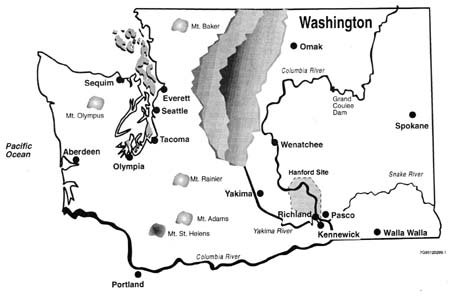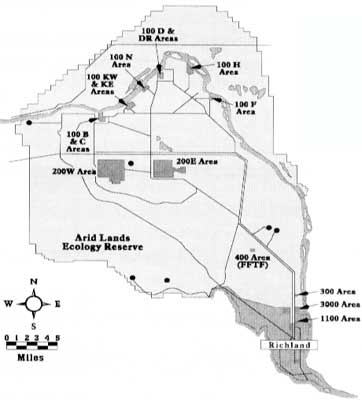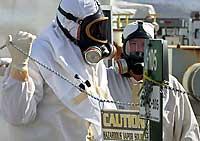 The Hanford Nuclear Reservation, located in southeastern Washington, is the most contaminated site in the Western Hemisphere. As much as 450 billion gallons of contaminated wastes have been dumped into unlined soil trenches at Hanford. More than a third of the 177 underground storage tanks have leaked, resulting in more than a million gallons of liquid High-Level Nuclear Waste contaminating groundwater near the Columbia River. Based on the 2004 Hanford Solid Waste Environmental Impact Statement, the US Department of Energy (USDOE) intends to ship several thousand truckloads of radioactive toxic waste from nuclear facilities around the country to be stored at Hanford.  Under the Federal Superfund Law and the State Model Toxics Control Act, no new waste can be brought to a contaminated facility until the existing contamination is brought into compliance with the law. So, on November 2, 2004, Washington voters overwhelmingly passed Initiative 297, now known as the Clean-Up Priority Act, to require Washington to use existing laws to clean up the mess at Hanford before new waste can be brought in. The USDOE promptly filed suit to overturn the initiative. As a result, the State of Washington has not been able to enforce the initiative at Hanford. On the other hand, when I-297 was put on the ballot, the USDOE finally ended the practice of dumping in unlined trenches. The bill to clarify specious claims about I-297, SB 5445, was made by the USDOE in their lawsuit and passed in the Washington State Senate in April of 2005. Both SB 5445 and its companion bill, HB 1474, died in committee in the House. However, by resolution, they have been reintroduced and retained in present status. As of January 2007, the legislation is still pending.
Hanford occupies 560 square miles. |
||

Downwind from Hanford - by Bunky Echo-Hawk of the Yakima Nation
The largest challenge today will be to push forth the cleanup efforts of the Hanford Site without compromising the rights of the Native Americans to the already diminishing land they claim. There are more than 120 recognized tribal archaeological sites along the Hanford Reach. |
||
|
Vapors may pose health risk to workers Recently proposed budget cuts for the construction of Hanford's vitrification (glassification) plant reduced spending for 2006 from $690 million to $526 million, costing jobs and delaying clean-up. All the while, many Hanford workers are battling work-related illnesses such as Chronic Beryllium Disease from breathing in on-site toxic contamination. |
||

Historic Hanford
1986: 20,000 documents that had been kept secret are released to the public, including information about the Green Run, an intentional release of radioactive iodine 131 for two days in 1949. Radiation levels higher than government-established limits reached as far north as Spokane and as far south as California. 1989: Tri-Party Agreement (TPA) is signed by the U.S. Department of Energy, Washington State Department of Ecology and the U.S. Environmental Protection Agency for clean-up of Hanford. This is the legally binding agreement that governs clean-up of Hanford through a series of negotiated milestones. 1989: Environmental public interest groups begin working together as the Hanford Public Interest Network (HPIN). In 2006, the agreed upon number of meeting dates was cut from six meetings per year to four. 1989: The Hanford Dose Reconstruction Project begins to look into the health impacts of the 1949 Iodine 131 releases. Impacted residents are called "downwinders." 1992: Heart of America Northwest sues to stop the discharge of two billion gallons of untreated liquid wastes, including cooling waters containing hazardous wastes. 1994-95: As a result of the 1992 lawsuit, USDOE stops discharging these untreated liquid wastes. 1994: The Hanford Advisory Board (HAB) is established, consisting of 32 stakeholder positions from around the region that advise USDOE on clean-up. The HAB meets six times a year through out the region. 1996: Public involvement in the USDOE Budget Prioritization process leads to the implementation of annual public hearings on budget. According to the TPA, meetings are supposed to occur in any community that requests a meeting. In 2005 this provision is not upheld. 2000: Fast Flux Test Facility (FFTF) nuclear reactor is deactivated, preventing the generation of more nuclear waste. In addition, shutdown of the FFTF rerouted $30 million a year, the amount it cost to run the FFTF, to the clean-up project. 2003: Representatives Jay Inslee (D-1,WA) and Adam Smith (D-9,WA) introduce legislation (H.R. 2508) to stop the practice of USDOE dumping radioactive, toxic waste in unlined soil trenches at Hanford. USDOE promises to end the practice soon after the legislation is introduced, but the practice resumes shortly thereafter. 2003: Heart of America Northwest lobbies Washington State Legislature and Washington Department of Ecology to use existing State and Federal Hazardous Waste Laws to require the USDOE to clean up contamination at Hanford. This effort was not successful. 2004: USDOE releases Hanford Solid Waste Environmental Impact Statement announcing that the preferred alternative is to dump several thousand truckloads of radioactive waste from the nation's nuclear weapons facilities at Hanford. 2004: Initiative 297 is filed with record number (282,000) of signatures for an Initiative to the Legislature. The purpose of the initiative is to stop Hanford from becoming a National Radioactive Waste Dump and require that no new waste can be brought to Hanford until the existing contamination is cleaned up. 2004: Pressure from Initiative 297 being on ballot causes USDOE to promise to stop dumping waste in unlined soil trenches. 2004: Initiative 297 passes with almost 70 percent support statewide, winning in 37 out of 39 Washington counties. 2004: USDOE sues to enjoin implementation of Initiative 297. There is currently an injunction in place on implementation and interpretation of I-297 against the Washington Department of Ecology. 2005: Sponsors of Initiative 297 introduce legislation in Washington State Legislature to clarify specious claims made by USDOE in lawsuit. SB 5445 passes in Senate surpassing 2/3 majority vote required to amend an initiative with in two years. 34 yays, 15 nays. 2005: FFTF sodium reactor core drilled, eliminating possibility of restart. 2005: USDOE and the Bush Administration implemented planned cuts Hanford clean-up budget of $340 million dollars. This cut includes $315 million taken from clean-up funding and 25 million diverted from clean-up to security. 2005: Hanford workers afflicted with Chronic Beryllium Disease (CBD) and other radiation exposure illnesses begin to organize against Hanford's self insurance program due to lack of responsiveness to worker claims. Workers are seeking move compensation oversight from Hanford's private contractor to State of Washington Labor and Industries. 2005: First awards delivered in the Hanford Downwinder Trial. Two of six bellweather plaintiffs received monetary awards for their thyroid cancers. 2005: USDOE and the Bush Administration cuts funding for Hanford's vitrification (glassification) plant from the $690 million needed annually to $526 million for fiscal year 2006, including a $100 million cut that resulted from criticism over mismanagement of the project. January 2006: Due to a state lawsuit, the U.S. Department of Energy cannot import four types of radioactive waste: low-level, mixed low-level, transuranic, and mixed transuranic. May 2006: The finish date for cleanup at Hanford is pushed back from 2011 to 2017 or beyond. June 12, 2006: U.S. District Judge Alan McDonald strikes down Initiative 297 (Cleanup Priority Act), saying it is unconstitutional. Heart of America Northwest is currently in the midst of a legal battle, fighting hard to appeal the decision. 2006: Governor Christine Gregoire is hesitant to include Hanford in the Bush Administrationís Global Nuclear Energy Partnership (GNEP) due to the risk it poses on Hanford waste cleanup. The purpose of GNEP is to more effectively recycle or reprocess spent nuclear rods and to develop a safer nuclear energy with far less radioactive waste. |
||
